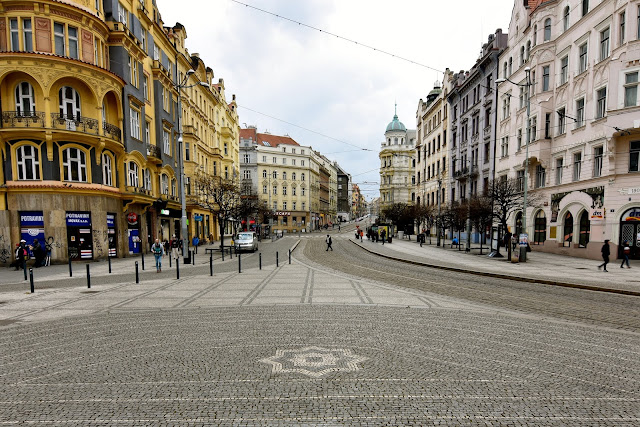Pitter Patterns
A mostly-pics post, looking at the sidewalks of Prague.
I started collecting pictures of sidewalks in 2010 with the intention of writing a post. (Not unlike the Prague Portals post.)
But then a very thorough article — "History At Our Feet: The Stories Behind Prague's Pavements" — was published on the subject last fall in The Bridge, the magazine of the International Women's Association of Prague (an NGO of which I'm a member).
Why try to expand on that? I'll quote it liberally, but I encourage you to click on over to IWAP and read it to get more of the history.
According to Schindele in The Bridge article:
"The main expansion and improvement of the pavements started in the first half of the 19th century. In 1920, Leopold Boch, a paver from Vienna, created the first mosaic patterns to decorate the streets in the Old Town. The marble for the cobbles was brought from quarries in the vicinity of Prague and came in three main colors: pink, gray, and white. The most common combination was pink and gray, while white cobbles were put around important buildings like town halls, some churches, and the courthouses. Between the World Wars, most of Prague’s streets received mosaic patterns made of good materials in all three colors. During the Communist era, according to a poignant placard in the Museum of Communism, the city was “changing into ruins,” and many of the beautiful sidewalk patterns were dug up or paved over in concrete. But the trend since 1989 has been to restore the streets to the way they were when the mosaic patterns flourished."
Sidewalk pavers can be used to communicate something about the building or the business therein.
The above design can be found in front of the Legion's Bank, honoring an important date in that building's history (though, apparently not the date it was completed, as that seems to be 1922 according to this article).
Sometimes patterns commemorate a piece of Prague history.
In 1621, 27 leaders of the Bohemian rebellion against the Habsburgs were executed in Old Town Square as a warning to others who might consider challenging the Habsburg rule. The crosses and date in the pavement (roughly) mark the spot near Old Town Hall where this took place.
More from Old Town Square above. You can see how much the patterns change just within the confines of this picture!
You can find 25 distinct patterns (per Schindele) in sidewalks around Prague. So this post is not an exhaustive assemblage.
I keep happening upon patterns I think are new to me. But it's hard to tell — some of the differences are subtle.
Sometimes the pattern changes within a block.
In the picture below, half the sidewalk abruptly changes to a checkerboard while the other half maintains the "bulls-eye" pattern. (I don't know what the patterns' official names are.)
History and beauty, right at your feet.
I started collecting pictures of sidewalks in 2010 with the intention of writing a post. (Not unlike the Prague Portals post.)
But then a very thorough article — "History At Our Feet: The Stories Behind Prague's Pavements" — was published on the subject last fall in The Bridge, the magazine of the International Women's Association of Prague (an NGO of which I'm a member).
Why try to expand on that? I'll quote it liberally, but I encourage you to click on over to IWAP and read it to get more of the history.
According to Schindele in The Bridge article:
"The main expansion and improvement of the pavements started in the first half of the 19th century. In 1920, Leopold Boch, a paver from Vienna, created the first mosaic patterns to decorate the streets in the Old Town. The marble for the cobbles was brought from quarries in the vicinity of Prague and came in three main colors: pink, gray, and white. The most common combination was pink and gray, while white cobbles were put around important buildings like town halls, some churches, and the courthouses. Between the World Wars, most of Prague’s streets received mosaic patterns made of good materials in all three colors. During the Communist era, according to a poignant placard in the Museum of Communism, the city was “changing into ruins,” and many of the beautiful sidewalk patterns were dug up or paved over in concrete. But the trend since 1989 has been to restore the streets to the way they were when the mosaic patterns flourished."
Sidewalk pavers can be used to communicate something about the building or the business therein.
 |
| Na Poříčí 24, in front of the gorgeous Rondo-cubist edifice built by Josef Gočár. |
The above design can be found in front of the Legion's Bank, honoring an important date in that building's history (though, apparently not the date it was completed, as that seems to be 1922 according to this article).
Sometimes patterns commemorate a piece of Prague history.
 |
| Near Old Town Hall. Photo source from the Královská Cesta site, where you can learn more about this historic event. |
In 1621, 27 leaders of the Bohemian rebellion against the Habsburgs were executed in Old Town Square as a warning to others who might consider challenging the Habsburg rule. The crosses and date in the pavement (roughly) mark the spot near Old Town Hall where this took place.
 |
| View from Old Town Hall tower, taken in 2010. (Right now this is obstructed by scaffolding.) |
More from Old Town Square above. You can see how much the patterns change just within the confines of this picture!
 |
| Owen and Garrett in Hradčany. |
I keep happening upon patterns I think are new to me. But it's hard to tell — some of the differences are subtle.
 |
| This one's pretty distinct! |
Sometimes the pattern changes within a block.
In the picture below, half the sidewalk abruptly changes to a checkerboard while the other half maintains the "bulls-eye" pattern. (I don't know what the patterns' official names are.)
 |
| In front of St. Anthony's in Strossmayer Square, our neighborhood |
History and beauty, right at your feet.











Weird question: in the sidewalk mosaic commemorating the 1621 hangings, why are there 28 little human markers rather than 27? Or have I spent too much time looking at it?
ReplyDeleteIt's likely that I spent too much time....
I count 27. There's a grid of 6x4 (making 24) and then another 3 in front of the grid. And then, flanking the date, there are 2 big crossed ... swords? (I'm not sure what they are. But I'm pretty sure they don't count in the tally.)
DeleteI think the crossed things are cannons. The butts of the guns are closer to the viewer, with the mouths at the other end.
DeleteSo interesting! Now I wish I had spent more time looking down instead of always looking up in awe at the buildings in Prague when I was there.
ReplyDeleteThere's so much to take in when you're walking around Prague! It would be easy to miss the sidewalks on your first trip. I guess you'll just have to return. Good thing you rubbed the statue of St. Jan Nepomuk!
DeleteMore to absorb during the short time I'll be in Prague!
ReplyDeleteCan't wait to share it all with you, Mom!!
Delete